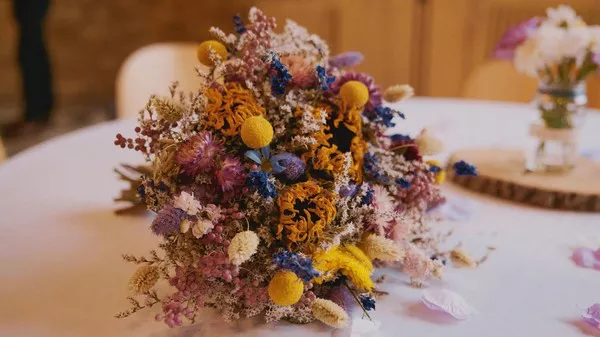Dried flowers are a wonderful way to preserve the beauty of nature. However, sometimes their natural colors may fade, or you might want to match them with a particular color scheme. Dyeing dried flowers is a great solution to enhance their appearance. This guide will provide you with a step-by-step process on how to dye dried flowers effectively, along with tips to ensure the best results.
Understanding Dried Flowers
Dried flowers retain much of their original structure and beauty but lose their vibrant colors over time. They are delicate and require gentle handling. Dyeing them can revive their appearance, making them suitable for various decorative purposes, from home decor to special events.
Materials Needed
Before you begin the dyeing process, gather the following materials:
- Dried flowers
- Fabric dye or floral spray paint
- Plastic or glass containers
- Water
- Protective gloves
- Plastic table cover or old newspaper
- Paper towels
- Hairspray or floral sealant (optional)
Step-by-Step Guide to Dyeing Dried Flowers
1. Preparation
Select Your Flowers:
Choose dried flowers that are clean and free of dust. Popular choices include roses, baby’s breath, and lavender. Ensure they are fully dried to avoid mold or damage during the dyeing process.
Choose Your Dye:
You can use fabric dye or floral spray paint. Fabric dye is ideal for achieving vibrant and uniform colors, while floral spray paint is excellent for creating more artistic effects.
Prepare Your Workspace:
Cover your work area with a plastic table cover or old newspaper to protect it from spills. Wear protective gloves to avoid staining your hands.
2. Dyeing with Fabric Dye
Mix the Dye:
Follow the instructions on the dye package to mix the dye in a container. Use hot water for the best results. The amount of dye and water will depend on the intensity of color you want.
Submerge the Flowers:
Dip the dried flowers into the dye mixture. Use a gentle swishing motion to ensure even coverage. For a more saturated color, leave the flowers in the dye for several minutes.
Dry the Flowers:
Remove the flowers from the dye and place them on paper towels to dry. You may need to hang them upside down to prevent the petals from sticking together. Allow them to dry completely, which may take a few hours to overnight.
Optional Sealant:
Once dry, you can spray the flowers with hairspray or a floral sealant to preserve the color and provide extra protection.
3. Dyeing with Floral Spray Paint
Select Your Spray Paint:
Choose a floral spray paint designed for dried flowers. These paints are gentle and won’t cause the petals to become brittle.
Spray the Flowers:
Hold the spray can about 12 inches away from the flowers and apply the paint in light, even coats. Rotate the flowers to ensure all sides are covered. Avoid spraying too much in one spot to prevent drips.
Dry the Flowers:
Allow the flowers to dry completely, usually within an hour. Repeat the spray if necessary to achieve the desired color intensity.
See Also: How to Dry Flowers and Preserve Their Color?
Tips for Success
Test First: Always test the dye or paint on a small, inconspicuous part of the flower to ensure it achieves the desired color and doesn’t damage the petals.
Color Mixing: You can mix different dyes or spray paints to create custom colors. Experiment with blending to achieve unique shades.
Gentle Handling: Dried flowers are fragile. Handle them with care throughout the dyeing process to prevent petals from breaking.
Environment: Dye and spray paint in a well-ventilated area to avoid inhaling fumes.
Creative Dyeing Techniques
1. Ombre Effect
To create an ombre effect, dip only the tips of the petals in the dye and gradually submerge more of the flower to achieve a gradient look. Alternatively, use spray paint to lightly coat the top of the petals, gradually increasing the amount of paint as you move down the flower.
2. Two-Tone Flowers
For a two-tone effect, dip one half of the flower in one color and the other half in a different color. This technique works well with larger flowers like roses.
3. Splatter Effect
Use a toothbrush to splatter dye or paint onto the flowers for a speckled look. Dip the toothbrush in the dye or paint, then flick it onto the petals.
Maintaining Dyed Dried Flowers
To keep your dyed dried flowers looking vibrant for as long as possible, follow these maintenance tips:
- Avoid Direct Sunlight: Sunlight can fade the colors, so display your dyed flowers in shaded areas.
- Keep Dry: Moisture can damage dried flowers and cause the dye to run. Ensure they are kept in a dry environment.
- Dust Regularly: Use a soft brush or a can of compressed air to gently remove dust from the flowers.
Applications of Dyed Dried Flowers
Dyed dried flowers can be used in a variety of creative ways:
- Home Decor: Create stunning centerpieces, wreaths, and wall hangings.
- Events: Use them for weddings, parties, and other special occasions to match the color theme.
- Crafts: Incorporate them into handmade cards, scrapbooks, and other craft projects.
Conclusion
Dyeing dried flowers is a fun and rewarding process that can breathe new life into your floral arrangements. Whether you choose fabric dye for a uniform color or floral spray paint for artistic effects, the possibilities are endless. By following this guide and experimenting with different techniques, you can create beautiful, customized dried flowers that will brighten up any space.
By taking the time to dye your dried flowers, you not only enhance their aesthetic appeal but also extend their longevity, allowing you to enjoy their beauty for much longer. Happy dyeing!


